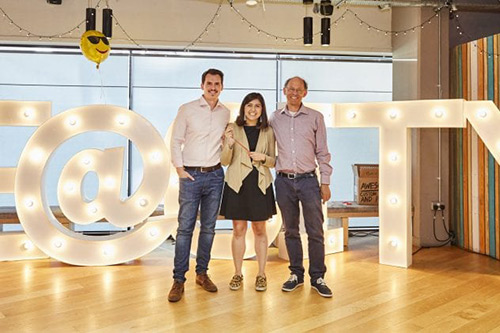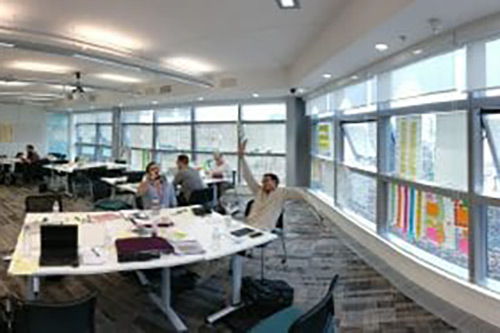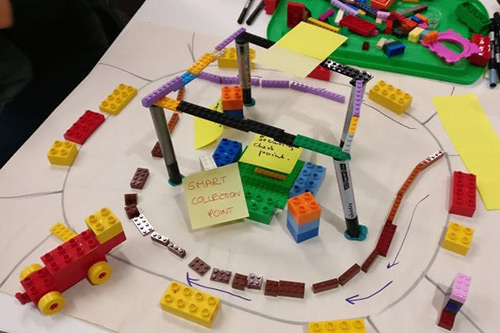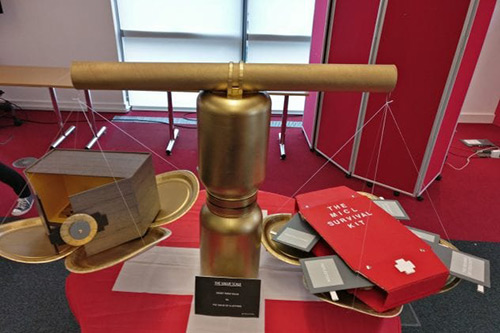What to expect on the Cass Innovation, Creativity and Leadership master’s
How’s the Michael doing?
Most people would simply consider it to be a very poor use of grammar, whereas those inside the circle know that ‘Michael’ is spelled ‘MICL’ – and it is not referring to a person but rather the Master’s in Innovation, Creativity and Leadership at Cass.
And yet, arguably, the MICL can be considered a very loyal and supportive friend who challenges you on a daily basis; the friend of a lifetime, the one that lets you reach high performance, if you only let him.
For the readers who are unaware of the programme: the MICL is a highly interdisciplinary master’s programme that explores and integrates perspectives on creative leadership and innovation from business and the arts, law, psychology, design and digital technology taught by a cross-functional team of educators and professionals. The master’s provides one with the necessary skills and knowledge to harness the creativity of colleagues, stakeholders, and clients within and outside of an organisation to successfully manage innovation projects and deliver breakthrough solutions.
My MICL experience
How I could possibly put my past year into words? The MICL spirit in me has come up with all kinds of great ideas, from self-written poems over songs or using my Creativity and Creative Industries module artefact as the star in a self-produced film of mine.
So much choice, so little time… For the sake of making myself clear to all the readers I shall, however, stick to traditional writing.
I started my first day on the MICL full of motivation with the hope of greatness and the desire to fill my hunger of learning. That was the intention and boy, I wasn’t prepared for what was yet to come. But see for yourself.
Throughout the programme we had an extensive variety of modules which I shall classify in this article as follow:
- Hulk modules (Law, Technology and Psychology)
- Captain America modules (Creative Problem Solving, Delivering Innovation and Leading Creative Design)
- Iron Man modules (Creative Writing and Creative Industries)
Hulk modules
I have experienced the Hulk modules as fundamental insights into current trends and research of core aspects that we encounter in everyday life. From intellectual property rights to the differences between intrinsic and extrinsic motivation, core concepts came to life right in front of my eyes.
We even developed a conceptual design of how amateur athletes can improve their skills and performance which earned our group the runner-up prize from Made@City 2018.

Captain America modules
Whereas the Hulk modules have been all around pre-known subjects, the Captain America modules opened my eyes to a whole new way of thinking and working. Moreover, the concept of creative leadership made me realise the unused resources of human capital that so many organisations have at their disposal.
The Creative Problem Solving module, as an example, not only provided us with insights into team dynamics and the differences and power of problem-solving styles but also showed us how to organise and facilitate workshops.
The secret ingredient, for everyone who hasn’t realised it yet, are post-its. You don’t believe me? Sit through the module and then we can talk again.

While we furthered our understanding of what innovation is and how it works in the module Delivering Innovation, we also embraced the power of prototyping and the concepts of continuous improvement in Leading Creative Design, which introduced us to the value of service design thinking.
Any programme that asks you to play around with LEGO and any other type of crafting materials is by principle a very good module.
As part of our assignment, we also had to use a sketchbook, which I considered a challenge by itself. And yet, just like with many things in life, I had to do less complaining and more sketching.
The result: a completed sketchbook that showed my learning curve, positively correlated the more natural sketching became. For all the readers who do not know it yet, there is a difference between sketching and drawing! If you don’t believe me, look it up.
When the module came to an end, even I had to agree with our professor that service design thinking and its methods do indeed work.

Iron Man modules
Remember that I said I wasn’t prepared for what was yet to come? I shall introduce to you the Iron Man modules. These were the modules in which we could let go of our creative side. We could simply be us and transfer our personality and values into our work.
Sounds pretty easy, doesn’t it? And yet, it all started with a room of grown-up adults passing around tissues to fight our emotions. The power of storytelling was experienced by each one of us from the very first moment onwards.
Over the duration of the Creative Writing module, it made me realise that the fundamental aspects of writing fairy tales and screenplays can directly be applied to how we communicate at work and in our private lives.
After all, the way we express ourselves not only reflects how we are perceived by society, but also what makes us unique. As Stephen King puts it in his book, “Writing isn’t a popularity contest, it’s not the moral Olympics, and it’s not church” (On Writing, 2000).
The one that rules it all: Creativity and the Creative Industries. This module introduced us to the world of the arts and how they impact our everyday lives. What seemed to be fun and joyful for many was the complete opposite for me.
I struggled; big time. More than with any other modules I simply was not convinced how this can add any value to life.
And yet, I can’t say how wrong I was once again. I must highlight, however, that this realisation only came to me after the module was completed. I felt like I needed to take a step back, digest and re-evaluate what I had experienced.
I especially believe that the many guest speakers we had and excursions we undertook enhanced my integral thinking of how different aspects of the arts play into personal development and what is needed to overcome personal barriers.

In a TED Talk in 2010, Simon Sinek states, “People don’t buy what you do, they buy why you do it.”
Why I studied the MICL
For a very similar reason I decided to pursue the MICL. How can I know what I want without knowing myself? How can I lead others, without knowing my own strengths and weaknesses?
The MICL is all about personal development and in my case, it has turned into a state of mind. Whenever I hit a dead-end, I put my MICL hat on and think, what would my good friend MICL do?
Over the programme, there was one quote that stuck with me from John Masefield:
And there were three men
Went down the road
As down the road went he:
The man they saw,
The man he was,
The man he wanted to be.
This very quote highlights one of the most important tools and aspects we have learned and incorporated on a daily basis since starting with the MICL. The power of reflection. The MICL makes you think. Not only about the fast paced environment we are living in and the business decisions and solutions we are working on, but also who you are as a person, what you want out of life and what gaps need to be filled to achieve your goals.
The programme might have come to an end, but the MICL spirit will live on forever.
A final note: If Marvel ever decides to introduce a new superhero, they should take a close look at the MICL!
Pascal Rota, Innovation, Creativity and Leadership (2018)